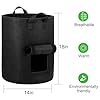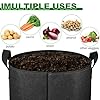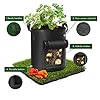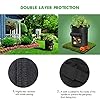Potatoes are easy to store over the winter. If your soil is isn't too clumpy, you can easily bush them off prior to storage, or if you wish to wash them, just make sure that you dry them well before you place them in an open storage bin or box. To allow for proper "curing" (drying) of any damage done to the potatoes while harvesting, keep them for a minimum of two weeks in temperatures that are approximately 55-65 F degrees and humidity between 85-95 percent. After the damages have properly "cured," they can be moved to storage areas as low as 35-40 F degrees with moderate humidity and excellent ventilation which will allow them to stay fresh for up to 8 months.
NOTE: If you do store them at these colder temperatures (like in a refrigerator), remove them from this cold storage and place them at room temperature at least a couple weeks before you plan to cook them as cold temperatures like these can cause their natural starch to convert to sugar that converts to a toxin if cooked immediately at that state. You can mitigate this problem by removing them from refrigeration storage at least a couple weeks before you cook them as this will allow their sugar to convert back into natural starch and mitigate against the health risks associated with cooking the sugars in ultra-cold potatoes.
Also, note that if potatoes are stored in warmer temperatures all the time, they will tend to sprout and shrivel sooner. Proper ventilation in whatever bin and temperature you choose to store them in is absolutely essential for proper maintenance of the potatoes. To aid with air circulation, do not to pile your potatoes any higher than 6 to 8 inches. Bins or boxes with slats or gaps in the sides are also helpful for ventilation.
If you wish to save a few medium potatoes for planting in early spring, move those potatoes to room temperature (at least 65 degrees Fahrenheit) approximately two months before you plan to plant them in the garden as this will allow them to spout before you plant them, which will jump start your potato garden in the spring.
Prior to cooking, remove any green spots that have developed due too much exposure to sunlight and watch for any rotting spots on the potatoes. Green spots indicate that a toxic substance called solanine has developed on the potato. This can be easily removed by cutting or peeling away the green areas of the potato. The rest of the potato is fine to eat once the green areas containing solanine have been removed. However, any form of rotting can ruin the whole potato and those around them, so be sure to discard any potatoes that have rotting spots.



![[Fabric Material]:Made of thickened nonwoven fabric,high strength, excellent anti-ultraviolet performance, long durability, good air permeability and water permeability. [Pack Size]: 4 packs,10 gallons potato grow bags with handles,10 gallon pot size...](https://m.media-amazon.com/images/I/41JCOQODdAL._SL160_.jpg)












